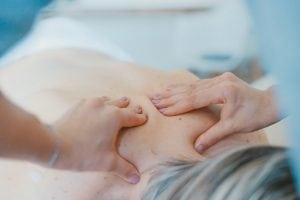 Today, more and more people are trying to avoid excessive pharmacological effects on their bodies. This practice helps to prevent dangerous complications that occur with prolonged treatment with antibiotics or anti-inflammatory drugs. Manual therapy is an excellent solution for normalizing the work of the musculoskeletal system.
Today, more and more people are trying to avoid excessive pharmacological effects on their bodies. This practice helps to prevent dangerous complications that occur with prolonged treatment with antibiotics or anti-inflammatory drugs. Manual therapy is an excellent solution for normalizing the work of the musculoskeletal system.
Of course, the impact of the therapist’s hands on the patient’s body can not replace full-fledged drug therapy or surgical intervention, but as an additional stimulus to recovery, non-traditional methods of exposure show excellent results. The main thing is to correctly assess the danger of a pathological condition and consult with an experienced doctor in advance.
Often people equate the concepts of manual therapy, osteopathy and massage. In fact, everything is much more complicated. An experienced specialist uses various, often author’s, techniques to influence certain points on the patient’s body, thereby improving blood circulation in the problem area and helping the body to recover faster after the disease.
In modern medicine, the effect of therapy by hands is divided into three main groups:
- Psychophysiological – tones up all systems, has a general strengthening effect.
- Neurophysiological – normalizes the functioning of nerve endings, improves the passage of impulses.
- Peripheral – restores soft tissues, renews cells, promotes the saturation of certain locations with oxygen and beneficial substances.
- A professional manual therapist can be a certified neurologist or traumatologist-orthopedist. Knowledge in these areas helps the specialist to recover from injuries, surgeries.
Indications and methods of manual therapy
Manual techniques, like any other methods of treatment, should be applied only after a qualitative examination and exclusion of possible contraindications. Most often, therapeutic palpation is used for physical trauma or pathology of the spine. Good results manual therapy shows during the rehabilitation period, after surgical operations and other medication.
Seek help from a specialist in alternative medicine should be found when:
- chronic headaches;
- frequent dizziness;
- violation of posture;
- spasms in the joints and muscles.
- In a separate group, diseases of the bone system are carried out. Herniated discs, arthrosis, osteochondrosis and other pathologies of the musculoskeletal system can be handled well, but require preliminary diagnosis with the help of special equipment.
Before starting treatment it is important to exclude all contraindications to manual therapy. To the prohibitions of the use of hands include fresh injuries of the spine, acute phases of infectious, viral diseases, tumors, high blood pressure, heart disease and blood vessels. With special care it is necessary to undergo a course of palpation for violations in the brain and spinal circulation.
Depending on the patient’s complaints and the results of a comprehensive examination, the specialist chooses a method of influencing the focus of the pathological condition.
The basic medical receptions
It is important to understand that one procedure for restoring health will not be enough. Usually, the positive effect of treatment becomes noticeable only after 3-5 treatment sessions. The effectiveness of therapy largely depends on the professionalism of the doctor and the correct choice of the technique of exposure.
The most widespread methods of manipulation are:
- positional (soft, smooth stretching of strained muscles and palpation in the region of the joints);
- rhythmic (stretching, rotating and squeezing techniques, allowing to work effectively with connective tissues);
- jogging (direct adjustment of displaced disks, elimination of the consequences of dislocations and restoration of the integrity of exostoses).
Many people, professionally involved in sports, are familiar with the term “post-isometric relaxation”. The essence of the technique is alternating intense tension and muscle relaxation. This effect helps to quickly remove pain in the cervical, thoracic and lumbar spine and joints.
Popular questions about manual therapy
Many people are wary of treatment with their hands. In most cases, the fear of treatment is associated with a lack of understanding of the principles and principles of such treatment. An experienced doctor will never harm a patient. Complications can occur only if the severity of the disease is underestimated to the patients themselves or the untimeliness of seeking help.
What questions do the patients usually ask the chiropractor? First of all, they are interested in how painful the procedure is. There should be no sharp pains. If there are painful spasms, then you need to stop the session and choose another way of exposure.
Another frequent question is the length of therapy. It should be understood that for the removal of symptoms of a pathological condition, usually 2-3 procedures are sufficient, but to fix the effect you need to visit the doctor at least 8-10 times. Accelerate treatment is possible with the help of reasonable sparing physical exertion, swimming, phytotherapy, the use of special corsets.
If everything is done correctly, then the body gradually picks up positive changes, and the doctor will only control the process of recovery.
Picture Credit: Toa Heftiba
